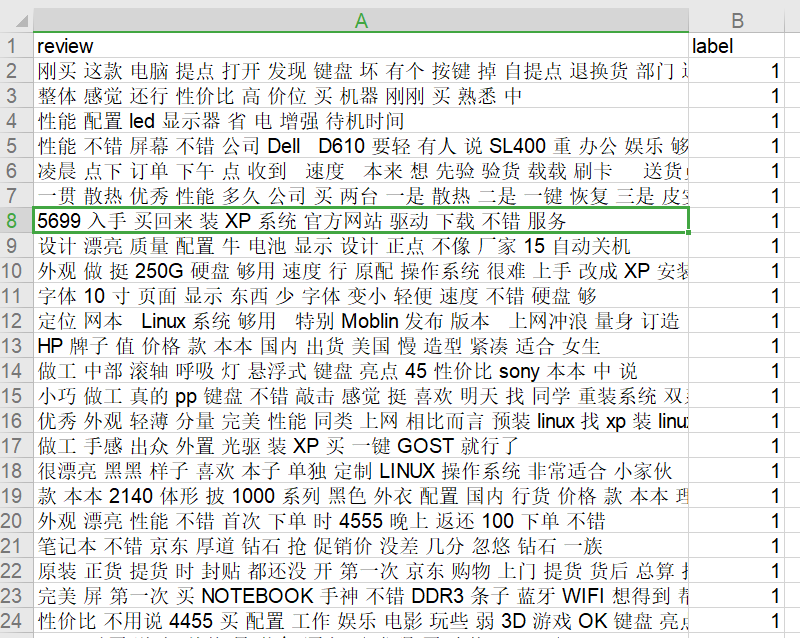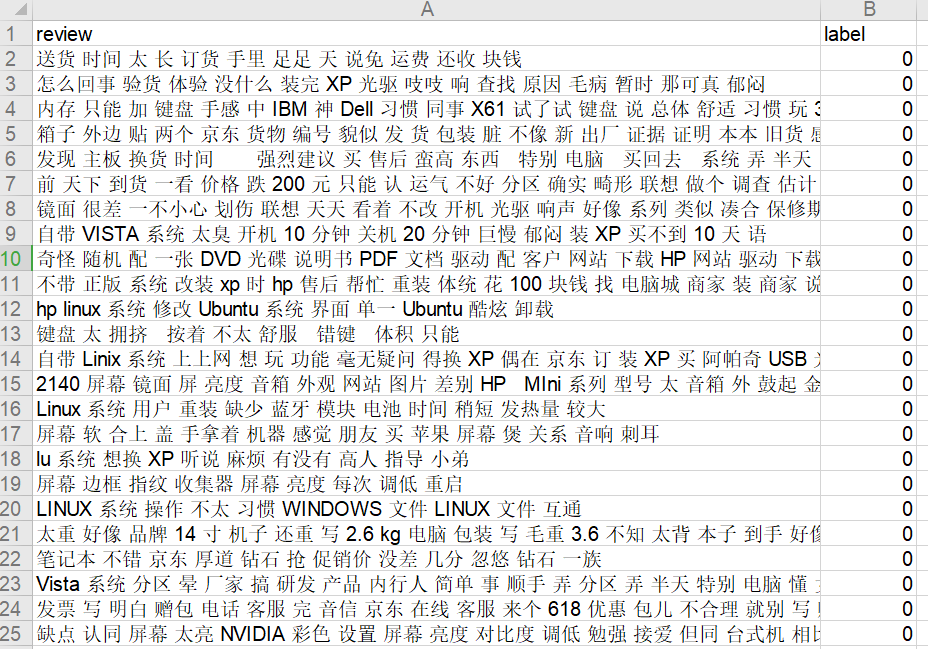输入
本篇文章中采用的是对京东某商品的2000个正面评价txt文档和2000个负面评价txt文档,总共是4000个txt文档。
一个正面评价txt文档中的内容类似如下:
1 钢琴漆,很滑很亮。2 LED宽屏,看起来很爽3 按键很舒服4 活动赠品多
一个负面评价txt文档中的内容类似如下:
送货上门后发现电脑显示器的两边有缝隙;成型塑料表面凹凸不平。做工很差,,,,,
输出
首先,是对4000个txt文档进行jieba分词后的输出结果。
对应上面输入中正面评价txt文档中的内容经过分词后,分词结果如下:
钢琴漆 很滑 很亮 LED 宽屏 很爽 按键 舒服 活动 赠品
对应上面负面评价txt文档中的内容经过分词后,分词结果如下:
送货上门 发现 电脑 显示器 两边 缝隙 成型 塑料 表面 凹凸不平 做工 很差
扫描二维码关注公众号,回复:
9180739 查看本文章


然后,把2000个正面评价txt文档和2000个负面评价txt文档的分词结果写入excel文件,每个分词结果都对应一个标签(正面评为1,负面评价为0),图示如下:


工具
本文使用工具为:Anaconda、PyCharm、python语言、jieba中文分词工具、网上下载的停用词文档
原理
使用jieba工具对每篇txt文档中的中文段落进行分词,分词后的结果去掉停用词后写入excel文档。
Python代码实现
1 from os.path import os 2 from xlwt.Workbook import Workbook 3 import jieba 4 5 # 将停用词文档转换为停用词列表 6 def stopwordslist(): 7 stopwords = [line.strip() for line in open('stopwords.txt', encoding='UTF-8').readlines()] 8 return stopwords 9 10 # 对文档字符串进行中文分词 11 def seg_depart(sentence): 12 print('sentence:{}'.format(sentence)) 13 # jieba工具分词结果 14 sentence_depart = jieba.cut(sentence.strip()) 15 # 停用词列表 16 stopwords = stopwordslist() 17 18 # 输出结果保存至outstr 19 outstr = '' 20 # 去停用词 21 for word in sentence_depart: 22 if word not in stopwords: 23 if word != '\t': 24 outstr += word 25 outstr += ' ' 26 print('outstr:{}'.format(outstr)) 27 return outstr 28 29 # txt文档的路径 30 #mypath = 'F:\\Jingdong_4000\\neg\\' 31 mypath = 'F:\\Jingdong_4000\\pos\\' 32 myfiles = os.listdir(mypath) 33 34 # txt文档名列表 35 fileList = [] 36 for f in myfiles: 37 if(os.path.isfile(mypath + '/' + f)): 38 if os.path.splitext(f)[1] == '.txt': 39 fileList.append(f) 40 # 待写入excel文件的每一行组成的列表 41 # excellist中的元素为列表,包括分词结果和标签两部分 42 excellist = [] 43 for ff in fileList: 44 f = open(mypath+ff,'r',encoding='gb2312', errors='ignore') 45 sourceInLines = f.readlines() 46 f.close() 47 str = '' 48 rowList = [] 49 for line in sourceInLines: 50 str += line 51 str = str.strip() 52 53 # 对str做分词 54 str = seg_depart(str) 55 str = str.strip() 56 rowList.append(str) 57 58 # 添加对应的标签0或1 59 #rowList.append(0) 60 rowList.append(1) 61 62 excellist.append(rowList) 63 64 # excel表格式 65 book = Workbook() 66 sheet1 = book.add_sheet('Sheet1') 67 row0 = ['review', 'label'] 68 69 for i in range(len(row0)): 70 sheet1.write(0,i,row0[i]) 71 72 # 两个for循环,第一个for循环针对写入excel的每行,第二个for循环针对每行的各列 73 for i, li in enumerate(excellist): 74 print('i:{}, li:{}'.format(i, li)) 75 for j, lj in enumerate(li): 76 sheet1.write(i+1,j,lj) 77 # 数据存入excel文件 78 #book.save('neg_fenci_excel.xls') 79 book.save('pos_fenci_excel.xls')
代码运行结果
生成如输出一节展示内容的excel文档。